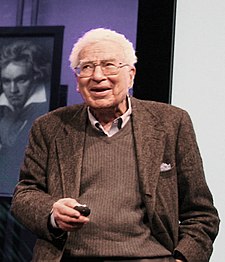 It is Murray Gell-Mann’s 80th birthday today! Congratulations! Gell-Mann is best known as the person who came up with the idea of quarks, the particles that make up (for example) protons and neutrons, the building blocks of atomic nuclei. (He’s known for a lot more than that, of course, and you can read about it online.)
It is Murray Gell-Mann’s 80th birthday today! Congratulations! Gell-Mann is best known as the person who came up with the idea of quarks, the particles that make up (for example) protons and neutrons, the building blocks of atomic nuclei. (He’s known for a lot more than that, of course, and you can read about it online.)
There’s an interview with Tom Siegfried in Science Now in honour of his 80th birthday*. Have a look. (See also an excellent article by Siegfried on Gell-Mann from August, focusing on the quark discovery, and the progress of new scientific ideas.)
Enjoy!
-cvj
*Thanks, Shelley Bonus!

















If i’m not mistaken that picture is from his TED lecture on beauty and truth in physics. Very much worth a watch if you haven’t already seen it.
http://www.ted.com/talks/lang/eng/murray_gell_mann_on_beauty_and_truth_in_physics.html
“It’s good that Gell-Mann managed to anticipate and avoid that censorship so cleverly, or we wouldn’t have quark theory”
Of course we would have it, though perhaps not the name “quark.” It was a typical example of a discovery whose time has come and Zweig and Gell-Mann were simply a bit faster to spot it. The vast majority of discoveries in science would have been made anyway at most a few years later if not for their discoverers. Very rarely are there people with unique insights which could not have been easily duplicated by their peers.
“Gell-Mann is best known as the person who came up with the idea of quarks, the particles that make up (for example) protons and neutrons, the building blocks of atomic nuclei.”
It took genius to publish such a speculative idea. According to William H. Cropper’s book Great physicists (Oxford U.P., p. 418), George Zweig’s paper on that theory was “emphatically rejected” by Physical Review but Murray Gell-Mann was “older and wiser” so he “anticipated a negative reception at the Physical Review to such bizarre entities as unobservable, fractionally charged elementary particles, and he published his first quark paper in Physics Letters. Zweig’s theory went unpublished except in a CERN report, but it and its author acquired a certain reputation. When Zweig sought an appointment at a major university, the head of the department pronounced him a ‘charlatan’.”
It’s good that Gell-Mann managed to anticipate and avoid that censorship so cleverly, or we wouldn’t have quark theory, with the SU(3) strong interaction part of the Standard Model. Pauli’s attempt to censor Yang-Mills theory in Feb. 1954 because of the particles are massless (Pauli had already discarded the idea for this “failure”) is another example (Yang simply sat down when Pauli persisted in objecting).
Another example is Oppenheimer’s attempt to censor Feynman’s path integrals without listening at all, as described by Freeman Dyson (Stuckelberg was working on the same idea independently, but was ignored and as with Zweig received no Nobel Prize). It’s remarkable that genius in the past has consisted to such a large degree in overcoming apathy (Oppenheimer was not just a stubborn exception who objected to path integrals. E.g., Feymman is quoted by Jagdish Mehra in The Beat of a Different Drum, pp. 245-248, saying that Teller, Dirac and Bohr all also claimed to have “disproved” path integrals: Teller’s disproof consisted of saying that Feynman didn’t have to take account of the exclusion principle, Dirac disproved it for not having a unitary operator, and Bohr disproved it because he believed that Feynman didn’t know the uncertainty principle: “it was hopeless to try to explain it further.” So without Dyson’s brilliance at explaining ideas, Feynman’s path integrals would probably have been ignored.)
Yes, I noticed that too. Excellent choice.
-cvj
Probably a frivolous observation, but I like the fact that he is photographed in front of a painting of Beethoven. Men of comparable stature in their respective fields I guess.
He’s a living building block of science!